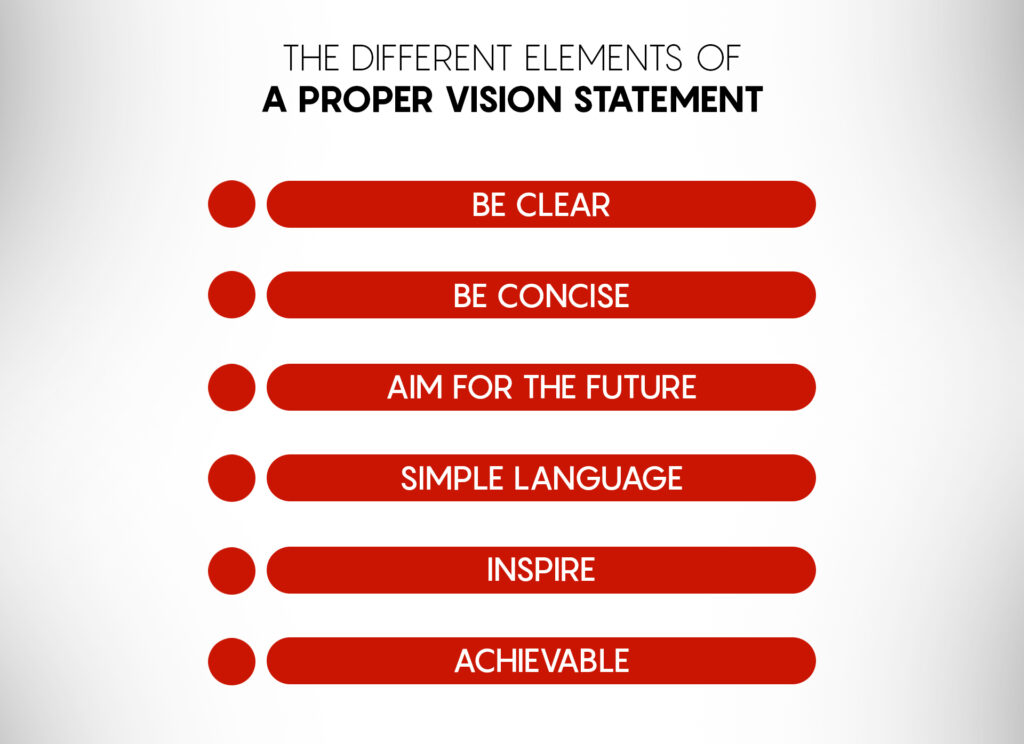You’re sitting across from the interviewer and out of nowhere they ask you that make-or-break question: “Where do you see yourself in 10 years?”. The pressure is on and everything is riding on this one answer that you give. This is basically what a ‘Vision Statement’ is, but for your business. Let’s break it down:
What Is A ‘Vision Statement’?
When we think of the word ‘Vision’ it isn’t some random, forgotten inspirational poster hanging on the office wall. The vision is essentially a line of thought or embodiment of everything you want your company to be.
What the business represents and where you as a business owner envision it being down-the-line in say the next 10 years or so. Hence, the term vision statement.
Think of it as a sort of a roadmap for keeping your head on straight as you navigate the business through today’s economy. It always helps to have a specific aim or goal in mind, something to work towards. This is the purpose of the vision statement.

‘‘
A business needs goals to grow and in order to set those goals, one needs to have a foresight or a vision for the organisation.
Don’t Get It Confused With The ‘Mission Statement’
Yes, the two are similar, but the distinction and purpose of both must be clearly understood and put to use accordingly. In terms of similarities, the mission and vision are both objects of business aspirations that embolden the confidence of investors and employees in your business and the potential that it has.
When we look at the differences, however, the ‘Mission Statement’ is one that is rooted in the present and is based around what the brand represents at the moment. It lays out the purpose and focus of the brand. At the other end, we have the ‘Vision Statement’, the purpose of which is to fulfil that mission somewhere in the future. Though both are equally important to have as an outline of the company’s core values, the vision takes precedent in terms of a predetermined path of sorts.
The Benefits Of Having A Well-Crafted Vision Statement
There are many advantages to having a vision for your organization, for one it helps align everyone’s views and efforts. When everyone is on-board with a purpose that has been unanimously agreed upon it helps redirect efforts towards pushing the brand in the direction of that goal in all the different areas of work.
It also gives you a set of standards to measure the performance of the business against. Ensuring that everything is still on track to meet said goal. A high-performance rate will, in-turn, attract a larger amount of people who will want to be a part of that goal and so you will have more talent to choose from in terms of workforce skill sets.
Most importantly, however, it provides a stable framework for the organisations in times of friction and restructuring especially when it is a major change in how the business is to operate in the future. It’s bound to be stressful. The vision is what will keep everything on track and running as smooth as possible in the face of such change.
The Downfalls And Challenges Of A Poor ‘Vision Statement’
A poorly thought-out vision has several drawbacks and can wind up causing more damage than good. It should be balanced when moving forward. It should be describing ideally where the business is expected to be down-the-line, without becoming too idealistic.
I shouldn’t be so grand that it becomes unattainable. If people in the company see that you as a business owner have set an unrealistic goal without the resources to back it up, it throws doubt into the mix and productivity takes a hit. You should also avoid using too much business jargon in the statement itself. Keep this as a rule of thumb. If you can’t recite it to someone off the top of your head or you have to explain it to them, it’s no good. Do yourself and your business a favour and start over.
Another important thing to keep in mind is that this is no time to get flowery with the language and go into detail about the company and how great it all is. This is simply an opportunity to tell the audience what they can expect, should they take this journey with you.
Last but not least – did you give it enough thought? Take all the time you need because what they say is true, the first impression is the best impression. So, make it count.
‘‘
It is always good to aim high and aspire for greater things when it comes to a vision, but it also equally important that the vision is something realistic and attainable.

How To Craft The Perfect ‘Vision Statement’
Coming up with the perfect statement for your vision may seem like a monumental task but it doesn’t have to be. The main thing you need to keep in mind is to make things as simple as possible. Having said that, there are a few pointers that one should have in mind when attempting a vision statement. First off, think of a vision statement that will help project a goal for the organisation and where it should be 10 years down the line. Something with a long-term goal is much more workable when you have a fixed timeframe in mind.
Next thing you will need to do – use clear, simple and jargon-free language. There is nothing more distracting and confusing than complicated business terms thrown in. Write it in the present tense. Keep it current to keep it relevant, even though it is predicting the future. While we’re on the subject of writing – keep in short. No one wants to read a paragraph.
Think of it in terms of a slogan, a quick catchy phrase that people can just say without thinking. One or two lines should do the trick.
Make sure that whatever is written, ultimately highlights and aligns with the brand’s values and helps communicate that to any random person who might happen to read it. Clarity is important for this.
Whatever you do, don’t make it plain and formal, add some spice to it, make it lively and showcase the passion for the business in such a way that others who read it also feel inspired by it.
Lastly, prepare yourself and the funds needed to back it up. There is nothing more depressing or blatantly lacking ambition, than a great vision statement without the finances or commitment to back it up. Have a plan in place to help communicate these ideas to the employees and customers. Show them that you have what it takes to achieve this and the resources to help make that dream a reality.
Some Resources And Templates To Help You Out
If your business is a start-up and can’t afford to hire a professional content writer to help craft the vision statement, don’t worry. There are a vast number of different online resources that can help you easily whip-up a neat statement. With the age of the internet, comes workshops, worksheets and templates all readily available. Some great examples include: Smartsheet – Vision Template Worksheet or even Template.net, which provide a variety of free, downloadable templates. So, really there is no shortage of resources to learn and write a vision statement for yourself. It just takes a little time to grasp the ideas.
To get a better idea of it, let’s take a look at some of the top-tier businesses that have come up with some truly innovative vision statements.
“To provide access to the world’s information in one click.”
IKEA
“To create a better everyday life for the many people.”
“Create economic opportunity for every member of the global workforce.”
Oxfam
“To create a world without poverty.”
Samsung
“Inspire the world, create the future.”
Remember It Doesn’t Predict The Future, Nor Is It Set In Stone
Having learnt all the benefits that a good vision statement can bring to the table, there’s one final lesson – Don’t cling to it with everything you have. It’s not a rule you have to always follow. Just a rough guideline of sorts. Nothing is set in stone. Yes, some companies do benefit from rigidly sticking to it but the same may not necessarily be true for your brand. Feel free to break away from it at any point you see fit. Think of the business as a child, you need to give it room to grow and evolve with time, if you get tied down to one statement and only use that to guide the growth of the organisation then it prevents the business from growing and you from seeing the need for a potential change.
The market is a dynamic place and is constantly changing and morphing into something bigger and the brand’s values have to grow with it. Expert economists suggest that the vision statement be re-invented every other financial quarter, see how the business has come and make adjustments accordingly. Don’t be afraid to change things up and keep the brand on the same track. It’s important that the statement aligns with the organisation culture and the brand value.
To learn more on ‘Organisation Culture’, check out our article on it – get the full picture.




